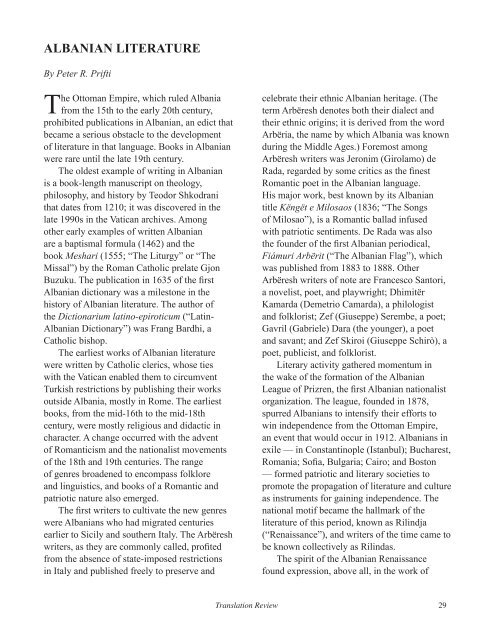Table of contents - The University of Texas at Dallas
Table of contents - The University of Texas at Dallas
Table of contents - The University of Texas at Dallas
You also want an ePaper? Increase the reach of your titles
YUMPU automatically turns print PDFs into web optimized ePapers that Google loves.
ALBANIAN LITERATURE<br />
By Peter R. Prifti<br />
<strong>The</strong> Ottoman Empire, which ruled Albania<br />
from the 15th to the early 20th century,<br />
prohibited public<strong>at</strong>ions in Albanian, an edict th<strong>at</strong><br />
became a serious obstacle to the development<br />
<strong>of</strong> liter<strong>at</strong>ure in th<strong>at</strong> language. Books in Albanian<br />
were rare until the l<strong>at</strong>e 19th century.<br />
<strong>The</strong> oldest example <strong>of</strong> writing in Albanian<br />
is a book-length manuscript on theology,<br />
philosophy, and history by Teodor Shkodrani<br />
th<strong>at</strong> d<strong>at</strong>es from 1210; it was discovered in the<br />
l<strong>at</strong>e 1990s in the V<strong>at</strong>ican archives. Among<br />
other early examples <strong>of</strong> written Albanian<br />
are a baptismal formula (1462) and the<br />
book Meshari (1555; “<strong>The</strong> Liturgy” or “<strong>The</strong><br />
Missal”) by the Roman C<strong>at</strong>holic prel<strong>at</strong>e Gjon<br />
Buzuku. <strong>The</strong> public<strong>at</strong>ion in 1635 <strong>of</strong> the first<br />
Albanian dictionary was a milestone in the<br />
history <strong>of</strong> Albanian liter<strong>at</strong>ure. <strong>The</strong> author <strong>of</strong><br />
the Dictionarium l<strong>at</strong>ino-epiroticum (“L<strong>at</strong>in-<br />
Albanian Dictionary”) was Frang Bardhi, a<br />
C<strong>at</strong>holic bishop.<br />
<strong>The</strong> earliest works <strong>of</strong> Albanian liter<strong>at</strong>ure<br />
were written by C<strong>at</strong>holic clerics, whose ties<br />
with the V<strong>at</strong>ican enabled them to circumvent<br />
Turkish restrictions by publishing their works<br />
outside Albania, mostly in Rome. <strong>The</strong> earliest<br />
books, from the mid-16th to the mid-18th<br />
century, were mostly religious and didactic in<br />
character. A change occurred with the advent<br />
<strong>of</strong> Romanticism and the n<strong>at</strong>ionalist movements<br />
<strong>of</strong> the 18th and 19th centuries. <strong>The</strong> range<br />
<strong>of</strong> genres broadened to encompass folklore<br />
and linguistics, and books <strong>of</strong> a Romantic and<br />
p<strong>at</strong>riotic n<strong>at</strong>ure also emerged.<br />
<strong>The</strong> first writers to cultiv<strong>at</strong>e the new genres<br />
were Albanians who had migr<strong>at</strong>ed centuries<br />
earlier to Sicily and southern Italy. <strong>The</strong> Arbëresh<br />
writers, as they are commonly called, pr<strong>of</strong>ited<br />
from the absence <strong>of</strong> st<strong>at</strong>e-imposed restrictions<br />
in Italy and published freely to preserve and<br />
celebr<strong>at</strong>e their ethnic Albanian heritage. (<strong>The</strong><br />
term Arbëresh denotes both their dialect and<br />
their ethnic origins; it is derived from the word<br />
Arbëria, the name by which Albania was known<br />
during the Middle Ages.) Foremost among<br />
Arbëresh writers was Jeronim (Girolamo) de<br />
Rada, regarded by some critics as the finest<br />
Romantic poet in the Albanian language.<br />
His major work, best known by its Albanian<br />
title Këngët e Milosaos (1836; “<strong>The</strong> Songs<br />
<strong>of</strong> Milosao”), is a Romantic ballad infused<br />
with p<strong>at</strong>riotic sentiments. De Rada was also<br />
the founder <strong>of</strong> the first Albanian periodical,<br />
Fiámuri Arbërit (“<strong>The</strong> Albanian Flag”), which<br />
was published from 1883 to 1888. Other<br />
Arbëresh writers <strong>of</strong> note are Francesco Santori,<br />
a novelist, poet, and playwright; Dhimitër<br />
Kamarda (Demetrio Camarda), a philologist<br />
and folklorist; Zef (Giuseppe) Serembe, a poet;<br />
Gavril (Gabriele) Dara (the younger), a poet<br />
and savant; and Zef Skiroi (Giuseppe Schirò), a<br />
poet, publicist, and folklorist.<br />
Literary activity g<strong>at</strong>hered momentum in<br />
the wake <strong>of</strong> the form<strong>at</strong>ion <strong>of</strong> the Albanian<br />
League <strong>of</strong> Prizren, the first Albanian n<strong>at</strong>ionalist<br />
organiz<strong>at</strong>ion. <strong>The</strong> league, founded in 1878,<br />
spurred Albanians to intensify their efforts to<br />
win independence from the Ottoman Empire,<br />
an event th<strong>at</strong> would occur in 1912. Albanians in<br />
exile — in Constantinople (Istanbul); Bucharest,<br />
Romania; S<strong>of</strong>ia, Bulgaria; Cairo; and Boston<br />
— formed p<strong>at</strong>riotic and literary societies to<br />
promote the propag<strong>at</strong>ion <strong>of</strong> liter<strong>at</strong>ure and culture<br />
as instruments for gaining independence. <strong>The</strong><br />
n<strong>at</strong>ional motif became the hallmark <strong>of</strong> the<br />
liter<strong>at</strong>ure <strong>of</strong> this period, known as Rilindja<br />
(“Renaissance”), and writers <strong>of</strong> the time came to<br />
be known collectively as Rilindas.<br />
<strong>The</strong> spirit <strong>of</strong> the Albanian Renaissance<br />
found expression, above all, in the work <strong>of</strong><br />
Transl<strong>at</strong>ion Review 29

















